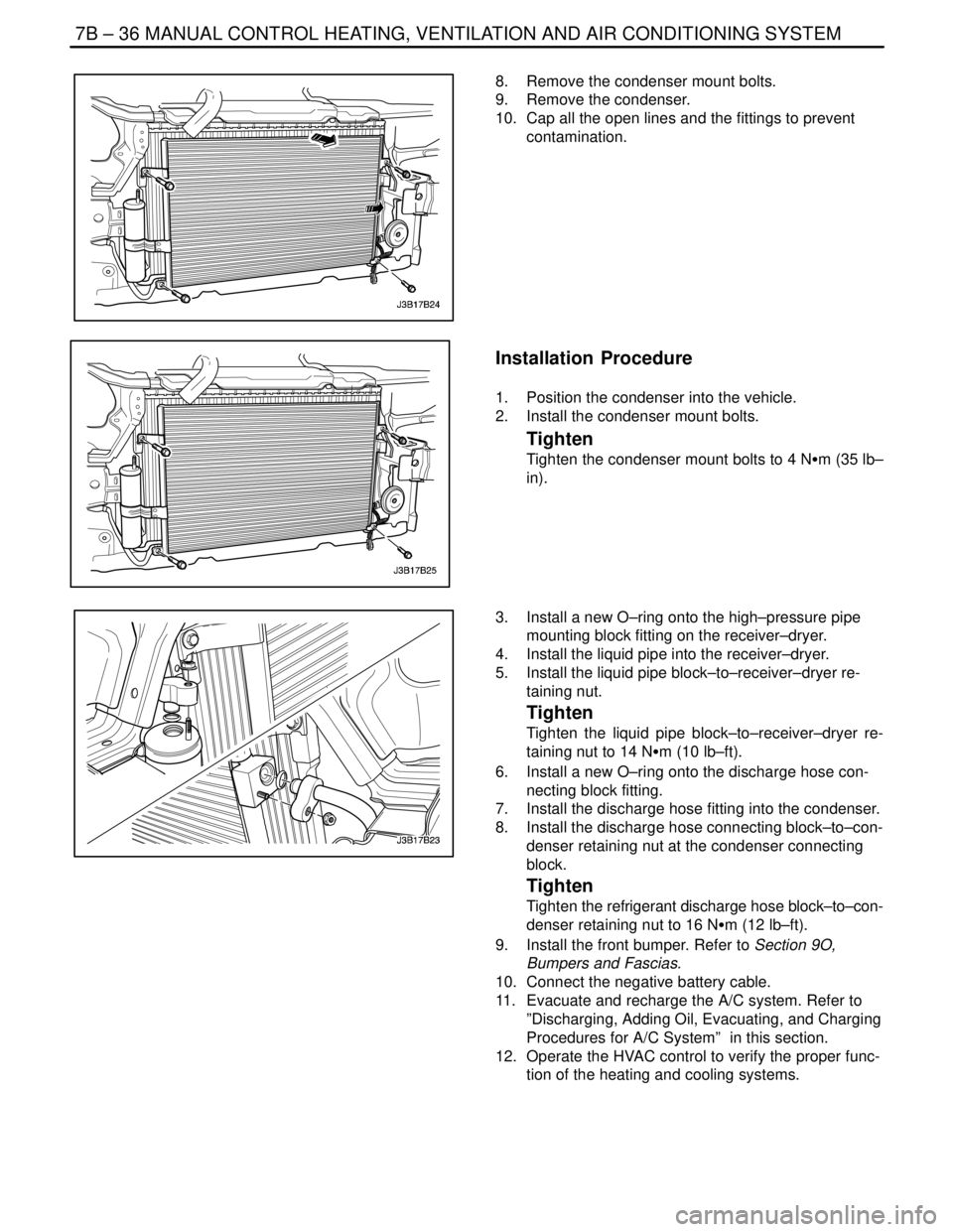2004 DAEWOO LACETTI cooling
[x] Cancel search: coolingPage 2038 of 2643

7B – 36IMANUAL CONTROL HEATING, VENTILATION AND AIR CONDITIONING SYSTEM
DAEWOO V–121 BL4
8. Remove the condenser mount bolts.
9. Remove the condenser.
10. Cap all the open lines and the fittings to prevent
contamination.
Installation Procedure
1. Position the condenser into the vehicle.
2. Install the condenser mount bolts.
Tighten
Tighten the condenser mount bolts to 4 NSm (35 lb–
in).
3. Install a new O–ring onto the high–pressure pipe
mounting block fitting on the receiver–dryer.
4. Install the liquid pipe into the receiver–dryer.
5. Install the liquid pipe block–to–receiver–dryer re-
taining nut.
Tighten
Tighten the liquid pipe block–to–receiver–dryer re-
taining nut to 14 NSm (10 lb–ft).
6. Install a new O–ring onto the discharge hose con-
necting block fitting.
7. Install the discharge hose fitting into the condenser.
8. Install the discharge hose connecting block–to–con-
denser retaining nut at the condenser connecting
block.
Tighten
Tighten the refrigerant discharge hose block–to–con-
denser retaining nut to 16 NSm (12 lb–ft).
9. Install the front bumper. Refer to Section 9O,
Bumpers and Fascias.
10. Connect the negative battery cable.
11. Evacuate and recharge the A/C system. Refer to
”Discharging, Adding Oil, Evacuating, and Charging
Procedures for A/C System” in this section.
12. Operate the HVAC control to verify the proper func-
tion of the heating and cooling systems.
Page 2053 of 2643

MANUAL CONTROL HEATING, VENTILATION AND AIR CONDITIONING SYSTEM 7B – 51
DAEWOO V–121 BL4
GENERAL DESCRIPTION
AND SYSTEM OPERATION
GENERAL INFORMATION
THE V5 A/C SYSTEM
The V5 variable displacement compressor along with the
thermal expansion valve on the evaporator, constitutes a
largely self–regulating system. There is no pressure cycl-
ing switch, no high–pressure cut–off switch and no low–
pressure cut–off switch. The compressor clutch is con-
trolled by the electronic control module (ECM), which
receives data from various engine systems and from a
pressure transducer located in the high–pressure refriger-
ant pipe. In normal operation, the clutch is engaged contin-
uously. Should one of the monitored conditions become
abnormal, the ECM will disengage the compressor clutch
until normal operation is restored. These conditions in-
clude the following:
S Wide–open throttle.
S High engine coolant temperature.
S High engine RPM.
S Refrigerant low pressure.
S Refrigerant high pressure.
The compressor clutch will remain disengaged until nor-
mal operation is established.
SYSTEM
COMPONENTS–FUNCTIONAL
Compressor
All compressors are belt–driven from the engine crank-
shaft through the compressor clutch pulley. The compres-
sor pulley rotates without driving the compressor shaft un-
til an electromagnetic clutch coil is energized. When
voltage is applied to energize the clutch coil, the clutch
plate and hub assembly is drawn rearward toward the
pulley. The magnetic force locks the clutch plate and
pulley together as one unit to drive the compressor shaft.
As the compressor shaft is driven, it compresses the low–
pressure refrigerant vapor from the evaporator into a
high–pressure, high–temperature vapor. The refrigerant
oil which is used to lubricate the compressor is carried with
the refrigerant. Refer to ”V5 Air Conditioning Compressor
Overhaul” in this section.
Condenser Core
The condenser assembly in front of the radiator consists
of coils which carry the refrigerant, and cooling fins that
provide the rapid transfer of heat. The air passing through
the condenser cools the high–pressure refrigerant vapor
and causes it to condense into a liquid.
Expansion Valve
The expansion valve is located with the evaporator core,
on the front passenger side fire wall.
The expansion valve can fail in three different positions:
open, closed, or restricted.
An expansion valve that fails in the open position will result
in a noisy A/C compressor or no cooling. The cause can
be a broken spring, a broken ball, or excessive moisture
in the A/C system. If the spring or the ball are found to be
defective, replace the expansion valve. If excessive mois-
ture is found in the A/C system, recycle the refrigerant.
An expansion valve that fails in the closed position will re-
sult in low suction pressure and no cooling. This may be
caused by a failed power dome or excessive moisture in
the A/C system. If the power dome on the expansion valve
is found to be defective, replace the expansion valve. If ex-
cessive moisture is found in the A/C system, recycle the
refrigerant.
A restricted expansion valve will result in low suction pres-
sure and no cooling. This may be caused by debris in the
refrigerant system. If debris is believed to be the cause, re-
cycle the refrigerant, replace the expansion valve, and re-
place the receiver–dryer.
Evaporator Core
The evaporator is a device which cools and dehumidifies
the air before it enters the vehicle. High–pressure liquid re-
frigerant flows through the expansion tube orifice and be-
comes a low–pressure gas in the evaporator. The heat in
the air passing through the evaporator core is transferred
to the cooler surface of the core, which cools the air. As the
process of heat transfer from the air to the evaporator core
surface is taking place, any moisture or humidity in the air
condenses on the outside surface of the evaporator core
and is drained off as water.
Receiver–Dryer
The sealed receiver–dryer assembly is connected to the
condenser outlet pipe. It acts as a refrigerant storing con-
tainer, receiving liquid, vapor, and refrigerant oil from the
evaporator.
At the bottom of the receiver–dryer is the desiccant, which
acts as a drying agent for the moisture that may have en-
tered the system. An oil bleed hole is located near the bot-
tom of the receiver–dryer outlet pipe to provide an oil re-
turn path to the compressor. The receiver–dryer is
serviceable only as an assembly.
Heater Core
The heater core heats the air before it enters the vehicle.
Engine coolant is circulated through the core to heat the
outside air passing over the fins of the core. The core is
functional at all times and may be used to temper condi-
tioned air in the A/C mode as well as in the heat or the vent
modes.
Page 2054 of 2643

7B – 52IMANUAL CONTROL HEATING, VENTILATION AND AIR CONDITIONING SYSTEM
DAEWOO V–121 BL4
SYSTEM COMPONENTS–CONTROL
Controller
The operation of the A/C system is controlled by the
switches and the lever on the control head. The compres-
sor clutch and the blower are connected electrically to the
control head by a wiring harness. The blower circuit is
open in the OFF mode. Airflow is provided by the four
blower speeds available in the remaining modes. Cooled
and dehumidified air is available in the MAX, NORMAL,
BI–LEVEL, and DEFROST modes.
The temperature is controlled by the position of the tem-
perature knob on the control head. A cable connects this
knob to the temperature door, which controls the airflow
through the heater core. As the temperature knob is
moved through its range of travel, a sliding clip on the
cable at the temperature valve connection should assume
a position ensuring that the temperature door will seat in
both extreme positions. The temperature door position is
independent of the mode control switch. The temperature
door on some models is controlled electrically, eliminating
the need for the temperature cable.
The electric engine cooling fan on some vehicles is not
part of the A/C control system; however, the fan is opera-
tional any time the A/C control is in the MAX, NORMAL,
or BI–LEVEL modes. Some models provide for engine
cooling fan operation when the controller is in the DE-
FROST mode. This added feature is part of the A/C con-
troller function and is aimed at preventing excessive com-
pressor head temperatures. It also allows the A/C system
to function more efficiently. On some models, the engine
cooling fan will be turned off during road speed conditions
above 56 km/h (35 mph), when the airflow though the con-
denser coil is adequate for efficient cooling. The operation
of the cooling fan is controlled by the powertrain control
module (PCM), or the engine control module (ECM),
through the cooling fan relay.
Pressure Transducer
The pressure transducer incorporates the functions of the
high–pressure and the low–pressure cutout switches
along with the fan cycling switch. The pressure transducer
is located in the high–side liquid refrigerant line near the
right front strut tower and the air filter assembly.
Wide–Open Throttle (WOT) Compressor
Cutoff
During full throttle acceleration on vehicles equipped with
multi–port injection (MPI), the throttle position sensor
(TPS) sends a signal to the PCM or the ECM, which then
controls the compressor clutch.
A/C Time Delay Relay
This relay on some vehicles controls the current to the en-
tire A/C system and provides a short delay of A/C opera-
tion upon start–up.
V5 COMPRESSOR–GENERAL
DESCRIPTION
Different vehicles with V5 compressors may exhibit differ-
ences in mounting and installation, but overhaul proce-
dures are similar.
Before removing the compressor or performing on–ve-
hicle repairs, clean the compressor connections and the
outside of the compressor.
Important : After removing a compressor from the vehicle
for servicing, drain the oil by removing the oil drain plug.
Also drain the oil from the suction and the discharge ports
to insure complete draining. Measure the amount of oil
drained, and record that amount. Discard the used oil and
add the same amount of new polyalkaline glycol (PAG) re-
frigerant oil to the compressor.
The compressor has been removed from the vehicle un-
less otherwise indicated.
Clean tools and a clean work area are important for proper
servicing. Keep dirt and foreign material from getting on or
into the compressor parts. Parts that are to be reassem-
bled should be cleaned with trichloroethane, naphtha,
stoddard solvent, kerosene, or equivalent solvents. Dry
the cleaned parts with clean dry air. Use only lint–free
cloths to wipe the parts.
V5 COMPRESSOR–DESCRIPTION OF
OPERATION
The V5 is a variable displacement compressor that can
match the automotive air conditioning (A/C) demand un-
der all conditions without cycling. The basic compressor
mechanism is a variable angle wobble–plate with five ax-
ially oriented cylinders. The center of control of the com-
pressor displacement is a bellows–actuated control valve
located in the rear head of the compressor. The control
valve senses compressor suction pressure.
The wobble–plate angle and the compressor displace-
ment are controlled by the crankcase suction pressure dif-
ferential. When the A/C capacity demand is high, the suc-
tion pressure will be above the control point. The valve will
maintain a bleed from crankcase to suction. With no
crankcase suction pressure differential, the compressor
will have maximum displacement.
When the A/C capacity demand is lower and the suction
pressure reaches the control point, the valve will bleed dis-
charge gas into the crankcase and close off a passage
from the crankcase to the suction plenum. The angle of the
wobble–plate is controlled by a force balance on the five
pistons. A slight elevation of the crankcase suction pres-
sure differential creates total force on the pistons resulting
in a movement about the wobbleplate pivot pin that re-
duces the plate angle.
The compressor has a unique lubrication system. The
crankcase suction bleed is routed through the rotating
wobble–plate for lubrication of the wobble–plate bearing.
The rotation acts as an oil separator which removes some
Page 2060 of 2643

AUTOMATIC TEMPERATURE CONTROL HEATING, VENTILATION, AND AIR CONDITIONING SYSTEM 7D – 5
DAEWOO V–121 BL4
DIAGNOSIS
GENERAL A/C DIAGNOSTICS
Refer to Section 7B, Manual Control Heating, Ventilation,
and Air Conditioning System for details of the following
procedures:
S A/C Performance Test.
S Insufficient Cooling ”Quick Check” Procedure.
S Insufficient Cooling Diagnosis.S Leak Testing the Refrigerant System.
S Low– and High–Side Pressure Relationship Chart.
S Pressure Test Chart (R–134a System).
S Pressure–Temperature Relationship of R–134a.
S Testing the Refrigerant System.
V5 SYSTEM AIR CONDITIONING AND AUTOMATIC
TEMPERATURE CONTROL (ATC)
SELF–DIAGNOSTIC CIRCUIT CHECK
The Daewoo fully automatic temperature controller
(FATC) contains a self–diagnosis function to aid in finding
any problem with the system. To enter the diagnostic
mode, perform the following procedure:
1. Turn the ignition to ON.
2. Set the temperature control to 26°C (79°F).3. Within 3 seconds, push the AUTO and the OFF
switches simultaneously, more than three times.
4. Count the number of times the temperature indica-
tor screen blinks.
5. If there are no error codes set, the screen will not
blink. When the controller indicates an error code,
proceed to the table for that code.
6. Push the OFF switch to return the controller to its
normal functions.
Page 2064 of 2643

AUTOMATIC TEMPERATURE CONTROL HEATING, VENTILATION, AND AIR CONDITIONING SYSTEM 7D – 9
DAEWOO V–121 BL4
StepNo Yes Value(s) Action
151. Check for
S A faulty thermostat.
S A failed coolant pump impeller.
S A restriction in the cooling system.
2. Make repairs as needed.
Is the repair complete?–System OK–
16Check the temperature of the heater inlet and outlet
hoses by feel.
Is the heater inlet hose hot and the outlet hose
warm?–Go to Step 18Go to Step 17
17Back flush or replace the heater core.
Is the repair complete?–System OK–
18Check the vehicle for cold air leaks at the
S Dash.
S Heater cases.
S Vents.
Are any leaks found?–Go to Step 20Go to Step 19
19Repair any cold air leaks.
Is the repair complete?–System OK–
20Check the coolant temperature sensor using the
tests in ”Code 3 – Coolant Temperature Sensor Er-
ror.”
Is there a problem indicated in the sensor, the sensor
wiring, or the controller?–Go to Step 21Go to Step 22
21Repair or replace the sensor, the wiring, or the con-
troller as required.
Is the repair complete?–System OK–
22Check the in–car sensor using the tests in ”Code 1
– In–Car Sensor Error.”
Is there a problem indicated in the sensor, the sensor
wiring, or the controller?–Go to Step 23Go to Step 24
23Repair or replace the sensor, the wiring, or the con-
troller as required.
Is the repair complete?–System OK–
24Check the ambient air temperature sensor using the
tests in ”Code 2 – Ambient Air Temperature Sensor
Error.”
Is there a problem indicated in the sensor, the sensor
wiring, or the controller?–Go to Step 25Go to Step 26
25Repair or replace the sensor, the wiring, or the con-
troller as required.
Is the repair complete?–System OK–
26Check the sun sensor using the tests in ”Code 5 –
Sun Sensor Error.”
Is there a problem indicated in the sensor, the sensor
wiring, or the controller?–Go to Step 27Go to Step 28
27Repair or replace the sensor, the wiring, or the con-
troller as required.
Is the repair complete?–System OK–
28Replace the ATC controller.
Is the repair complete?–System OK–
Page 2065 of 2643

7D – 10IAUTOMATIC TEMPERATURE CONTROL HEATING, VENTILATION, AND AIR CONDITIONING SYSTEM
DAEWOO V–121 BL4
NO COOL AIR FROM BLOWER
StepActionValue(s)YesNo
11. Turn the ignition to ON.
2. Observe the temperature indication screen of
the controller.
Does the digit flash on and off?–Go to Step 2Go to Step 3
2Run a self–diagnosis circuit check.
Does the display indicate a defect code?–Go to the table
for the code
that flashes.Go to Step 7
3Observe the blower motor operation.
Is the blower motor functioning at all?–Go to Step 4Go to ”Blower
Motor Does
Not Run at All”
4Use the blower push switch to cycle the blower
through its different speeds.
Does the motor function at different speeds?–Go to Step 5Go to”Code 6 –
Power Transis-
tor Error”
51. Run the blower and operate the MODE push
switch manually.
2. Check for airflow out the various outlets.
Does the air flow from the different outlets as it
should?–Go to Step 7Go to Step 6
61. Remove the heater outlet and check for ob-
structions.
2. Remove any obstructions found.
Is the heater operating?–System OKGo to Step 9
7Observe the air mix door motor (AMD) while chang-
ing the temperature setting from 18 to 32°C (64 to
90°F) and then from 32 to 18°C (90 to 64°F).
Is the AMD motor functioning properly?–Go to Step 8Go to”Code 3 –
Air Mix Door
Error”
8Perform the checks found in ”Insufficient Cooling
Diagnosis.”
Is the system operating normally now?–System OKGo to Step 9
9Place the controller in the AUTO mode.
Is smoke taken into the intake port of the in–car sen-
sor?–Go to Step 12Go to Step 10
10Check the intake hose for the in–car sensor.
Is the hose in good condition?–Go to Step 12Go to Step 11
11Repair or replace the intake hose.
Is the repair complete?–System OK–
12Check the in–car sensor using the tests in ”Code 1
– In–Car Sensor Error.”
Is there a problem indicated in the sensor, the sensor
wiring, or the controller?–Go to Step 13Go to Step 14
13Repair or replace the sensor, the wiring, or the con-
troller as required.
Is the repair complete?–System OK–
14Check the ambient air temperature sensor using the
tests in ”Code 2 – Ambient Air Temperature Sensor
Error.”
Is there a problem indicated in the sensor, the sensor
wiring, or the controller?–Go to Step 15Go to Step 16
Page 2072 of 2643

AUTOMATIC TEMPERATURE CONTROL HEATING, VENTILATION, AND AIR CONDITIONING SYSTEM 7D – 17
DAEWOO V–121 BL4
COMPRESSOR MAGNETIC CLUTCH DOES NOT ENGAGE
StepActionValue(s)YesNo
11. Remove the ATC Controller from the instru-
ment panel, keeping the wiring harness con-
nected.
2. Turn the ignition switch to ON.
3. Turn the A/C switch to ON.
4. Check the voltage between ground and termi-
nal A11 on the controller.
Is the voltage within the specified value?11–14 vGo to ”Insuffi-
cient Cooling
Diagnosis”Go to Step 2
2Replace the ATC controller.
Is the repair complete?–System OK–
Page 2219 of 2643

BODY WIRING SYSTEM 9A – 13
DAEWOO V–121 BL4
FUSE CHART
Engine Room Fuse Block
FuseRating/SourceCircuit
EF130AB+Battery Main (F13~F16, F21~F24)
EF260AB+EBCM, Oil Feeding Connector
EF330AB+Blower Relay
EF430AB+Ignition Switch–2
EF530AB+Ignition Switch–1
EF620AB+Cooling Fan Low Relay
EF730AB+Defog Relay
EF830AB+Cooling Fan HI Relay
EF920AIGN 2Power Window Switch
EF1015AIGN 1Fuel Connector, ECM (MR–140), LEGR, EI Sys-
tem
EF1110AB+ECM, Main Relay (Sirius D4)
EF1225AB+Head Lamp Relay, ILLUM. Relay
EF1315AB+Brake Switch
EF1420AIGN 2Power Window Switch
EF1515ALightHead Lamp HI
EF1615AB+Horn Relay, Siren, Hood Contact Switch
EF1710AB+A/C Comp. Relay
EF1815AIGN 1Fuel Pump
EF1915AB+Cluster, Key Remind S/W, Folding Mirror Unit,
MAP Lamp, Room Lamp, Trunk Open Lamp,
Trunk Open S/W
EF2010ALightHead Lamp Low
EF2115AIGN 1/B+EVAP Canister Purge Solenoid, HO2S, Cooling
Fan Relay
EF2215AIGN 1/B+Injector, EGR, EEGR
EF2310AIlluminationLicense Plate Lamp, Chime Bell, Tail Lamp,
Head Lamp
EF2415AB+Fog LampRelay
EF2510AIGN 2Electric OSRV Mirror
EF2615AB+Central Door Lock Unit
EF2710ALightHead Lamp Low
EF2810AIlluminationILLUM. Circuit, Head Lamp, Tail Lamp
EF2910ASpareNot Used
EF3015ASpareNot Used
EF3125ASpareNot Used